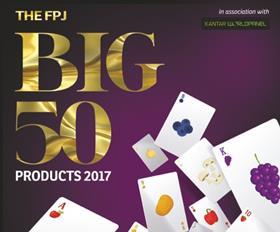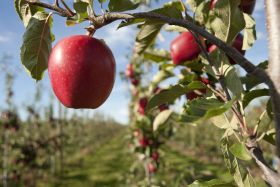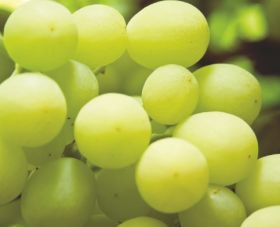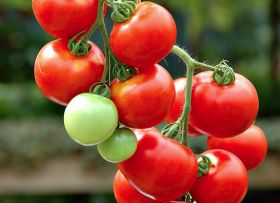
The FPJ Big 50 Products ranks the 50 best-selling fresh fruit and vegetable products by sales value, using Kantar Worldpanel data for the 52 w/e 21 May 2017.
1. Dessert Apples

'Apples still holding strong'
Value: £878.7m (+5.6%) Volume: 457.2m kg (-2.2%)
Apples continue to hold top spot in the FPJ Big 50 Products, but with real competition from innovative formats in grapes and berries, they are not sitting as comfortably as before.
Things haven’t been easy from a production point of view either, with frosts causing severe damage to orchards in both the UK and across continental Europe in April and that could lead to some price inflation going forward.
Nevertheless, the category is in positive value growth, which has been boosted by shoppers trading up into more premium varieties such as Pink Lady, Jazz and Kanzi, according to James Simpson of Adrian Scripps. Exchange rates have also been a contributing factor during the southern hemisphere season. “I would expect to see some price inflation after a difficult growing season,” says Simpson, “though we have to be careful that if price inflation is too aggressive it will turn people off the category.”
British growers remain upbeat, and Carol Ford, commercial director at AC Goatham & Son, points to the company’s ongoing orchard investment and tree-planting programme as evidence. “There is significant demand for top-quality British apples and pears and we are increasing our number of farms to help meet this, including the recent purchase of two new farms, adding a further 350 acres,” she says.
2. Grapes

'Grape category grows as prices rise'
Value: £810.3m (+4.4%) Volume: 232.4m kg (+2%)
Grapes is one of the biggest and most mature categories in fruit, meaning large gains are difficult to achieve. But that makes the current 4.4 per cent value and two per cent volume growth a solid achievement.
Nevertheless, it should be noted that this growth has mainly come from price rises, according to Kantar Worldpanel analyst William Strange, with 500g punnets of both white and red grapes rising as much as 22 per cent at Aldi. Meanwhile, there have been only slight increases in market penetration and shopper trips, as well as a reduction in trip volume, which has extracted £15.2m from the market.
The core consumers were adults aged over 65, accounting for 32 per cent of all grape occasions, while the strongest retailer value growth was seen at both ends of the price spectrum. Lidl (26.8 per cent) and Aldi (12.1 per cent) lead the way but they were closely followed by M&S (10.9 per cent) and Waitrose (6.9 per cent).
Across Europe the grape market has been under strong volume pressure in the past season with South Africa, Chile, India and Egypt all enjoying high yields. “South African exports to Europe as a whole were significantly higher this year and that’s created a lot of price competition due to volume pressure,” says Geoff Green of Capespan.
3. Tomatoes

'Brexit opportunity for tomatoes'
Value: £744.3m (+4.5%) Volume: 276.2m kg (+6.9%)
For one of the most purchased and established products in the fresh produce aisle to have seen such good value and volume growth over the past year is reflective of a mood of quiet optimism in the sector.
Despite the price war continuing to keep a lid on inflation, retail tomato sales have grown by £32m in the past year, with an extra 18m kg bought. With those figures largely pre-dating the hot British summer and high-quality crop, next year’s figures could look even more positive.
According to Paul Faulkner at Eric Wall Nursery, retailers are increasingly looking for British product, a trend that is expected to increase after Brexit and should encourage more investment in glass in this country.
The sector has also seen a raft of packaging innovation, such as Sainsbury’s cardboard packs for its Taste the Difference tomatoes and the arrival of more heat-sealed packaging. “All the retailers have been reformulating their packs and ranges in terms of the way they present tomatoes,” Faulkner says.
Growers remain focused on quality and flavour, meaning a skew towards more premium varieties, which is also nudging category values northwards.
North of the border, Scotty Brand has made moves to bring Scottish tomatoes back to market in a further sign of growing confidence in the sector.
4. Bananas

'Inflation brings growth back to bananas'
Value: £578.1m (+3%) Volume: 735.8m kg (+3%)
For a category as mature as bananas, three per cent value and volume growth is big news.
The major talking point in the category has been the increase in retail prices at the end of 2016, according to Compagnie Fruitiere UK commercial director Toni Direito. The banana market has been in growth since spring 2016, he told FPJ recently, with a slight increase in penetration also recorded.
Simon Trewin, commercial director at SH Pratt Group, says supermarket growth has helped drive banana sales, as well as inflation in the category itself. “The move to healthy eating and the convenience of a banana as part of breakfast or a packed lunch helps. I believe bananas will remain a favourite purchase,” he explains.
Changing usage occasions could help secure further growth, says Trewin, such as targeting breakfast, lunch and on-the-go occasions in line with research suggesting bananas are normally eaten before 5pm. “With consumers seeing tennis players at Wimbledon eating bananas through a match and marathons and fun runs giving them out, it helps promote bananas as an energy food,” he adds.
Growing conditions in the often volatile producer regions are currently “benign”, but ongoing stimulation to demand will help balance supply issues and keep the category in growth.
5. Strawberries

'March of the strawberries loses pace'
Value: £576.8m (+1.1%) Volume: 124.6m kg (-1.4%)
Strawberries account for 42 per cent of sales in the berry category and although there has been a slight decline in volumes, they remain the dominant product in soft fruit.
An early summer glut of strawberries caused by warm temperatures in May prompted Asda and Tesco to buy 700 and 500 extra tonnes of the fruit respectively, with some wholesalers reporting inconsistent quality and more Class II fruit following the heatwave. But in a bid to maintain product quality Berry Gardens’ chief executive Jacqui Green says the company has “invested significantly” in ensuring fruit is reduced to 1o°C within an hour of picking and 4°C within three hours.
Green says Berry Gardens growers have increasingly been planting new varieties such as Driscoll’s Lusa. “Coupled with the high levels of growing degree hours during March and April this year, availability has increased and several retailers have supported our growers by introducing larger packs earlier than normal,” she continues.
Drawing on Kantar data, Charlotte Knowles, head of brand and marketing at BerryWorld, adds that Tesco contributed the most growth to strawberries, adding £9.7m to the category. The introduction of Tesco’s farm brand Rosedene Farms “has attracted more customers to the category with an entry level price point,” she adds.



